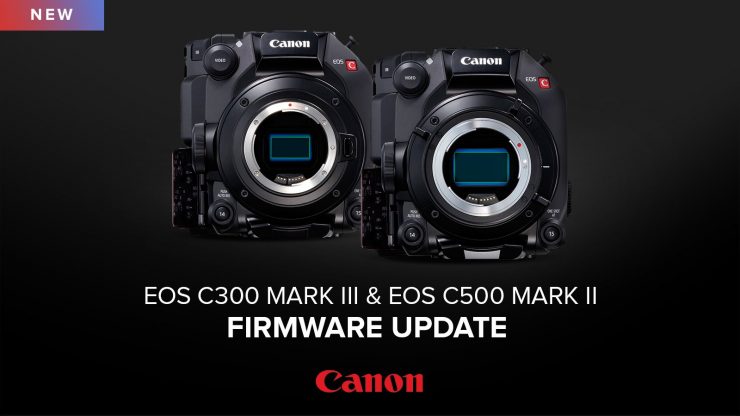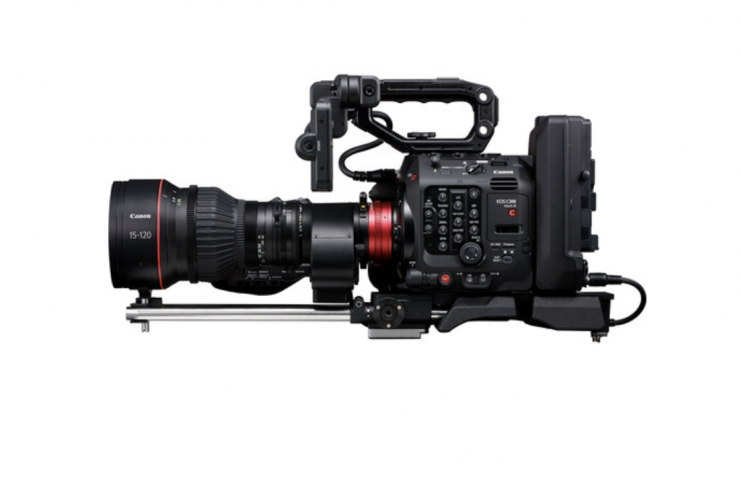
Canon has released a new Cinema EOS Firmware that is designed to enhance and strengthen the capabilities for live productions and the mid-to-low-end broadcast market.
The new firmware update is for the EOS C500 Mark II is 1.0.6.1, and EOS C300 Mark III is 1.0.4.1, enabling both cameras to be used within live environments.
Other new additions in the firmware include AF support when shooting 100p or 120p, and the addition of face detection when shooting in the Slow and Fast Shooting Mode. There is also finally the ability to display four channels of audio.
Key updates include
- Implementing XC protocol: integration into multi-camera solutions, supporting direct control via RC-IP100 and ethernet connections.
- Strengthening of AF features: 120p / 100p AF support, alongside face detection during Slow and Fast Shooting Mode.
- Audio 4ch display: the audio level display will show all four audio channels when this mode is selected.
- New accessory and lens support: allowing the EOS C500 Mark II and EOS C300 Mark III to work perfectly with both the CN8x15 IAS S E1/P1 and EU-V3, as well as support for the Flex Zoom series of lenses.

Firmware Version 1.0.4.1 Enhancements
- Adds support for EU-V3 Expansion Unit 3.
- Adds Focus Position Guide feature.
- Adds support for additional commands for Canon IP [XC Protocol].
- The following features are enabled when the following lenses are attached:CN8×15 IAS S/E1,CN8×15 IAS S/P1,
CN-E45-135mm T2.4 L F, CN-E45-135mm T2.4 L FP
- Displaying metadata, such as the model name and the focal distance of the lens attached.
- Displaying T number
- Support for Peripheral Illumination Correction and Chromatic Lens Aberration Correction.(EF only)
- Support for [Dual Pixel Focus Guide] (EF only)
- Enables face detection and tracking when S&F shooting frame rate is set from 24 to 120 frames per second.
- Adds support for 4CH display in audio meter.
- Improves the retention of the recording settings when switching between normal shooting and S&F shooting.
- Adds [Canon 709 / BT.709] to the Gamma/Color Space in Custom Picture setting.
- Adds [CMT 709] in LUT and Sub Rec Color Conversion.
- Adds [G Gain] in White Balance in Custom Picture settings.
- Adds support for the CFExpress VPG 400 (Video Performance Guarantee).
- Fixes minor issues when using the CINE-SERVO lens.
For further information, please refer to the latest version of the camera’s Instruction Manual, which is released with the firmware update.
- Please use an SD/SDHC/SDXC memory card that is 512MB or greater to perform the firmware update.
- After the firmware update has been performed, the camera’s menu settings will be reset. It is recommended that, prior to starting update operations, users save their menu settings as settings data to an SD card, separate from the one that will be used to carry out the update. This saved data can be loaded into the camera and the settings can be changed after the update has been completed. For further information on this, please refer to the section in the unit’s Instruction Manual titled “Saving and Loading Camera Settings”
- The downloaded folder contains the firmware (file name: VQA8.FIR / file size: 84,860,272byte), and instructions on the firmware update procedures (a PDF file in five languages: Japanese, English, French, Spanish and Simplified Chinese). Prior to starting the firmware update operations, please be sure to carefully review and confirm your understanding of these instructions.
The following items are required to perform this firmware update:
- Camera Body EOS C300 Mark III
- A computer (OS requirements: Windows 11, Windows 10, Windows 8.1)
- SD/SDHC/SDXC memory card with a capacity of 512MB or more (commercially available)
- An SD card reader/writer (commercially available) or an SD card slot built into the computer
- A fully charged battery pack for the camera
- Power adapter (commercially available, DC IN 12V terminal): 4-pin XLR plug (female connector), 12 V DC (acceptable range: 11.5 V to 20 V DC), 10 A (acceptable maximum load current)
- The firmware (the downloaded file)





